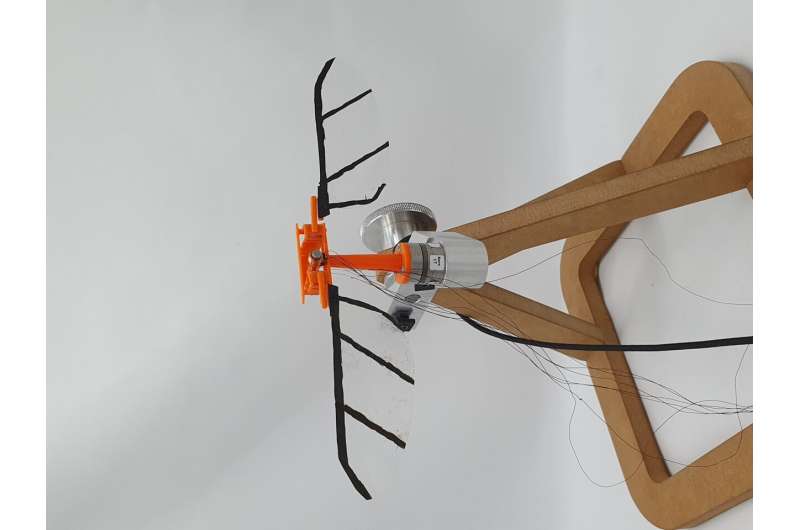
APRIL 27, 2021 by University of South Australia
Collected at: https://techxplore.com/news/2021-04-future-drones-resemble-million-year-old-machine.html?utm_source=nwletter&utm_medium=email&utm_campaign=daily-nwletter
University of South Australia researchers have drawn inspiration from a 300-million-year-old superior flying machine—the dragonfly—to show why future flapping wing drones will probably resemble the insect in shape, wings and gearing.
A team of Ph.D. students led by UniSA Professor of Sensor Systems, Javaan Chahl, spent part of the 2020 COVID-19 lockdown designing and testing key parts of a dragonfly-inspired drone that might match the insect’s extraordinary skills in hovering, cruising and aerobatics.
The UniSA students worked remotely on the project, solving mathematical formulas at home on whiteboards, digitizing stereo photographs of insect wings into 3D models, and using spare rooms as rapid prototyping workshops to test parts of the flapping wing drone.
Their findings have been published in the journal Drones.
Describing the dragonfly as the “apex insect flyer,” Prof Chahl says numerous engineering lessons can be learned from its mastery in the air.
“Dragonflies are supremely efficient in all areas of flying. They need to be. After emerging from under water until their death (up to six months), male dragonflies are involved in perpetual, dangerous combat against male rivals. Mating requires an aerial pursuit of females and they are constantly avoiding predators. Their flying abilities have evolved over millions of years to ensure they survive,” Prof Chahl says.
“They can turn quickly at high speeds and take off while carrying more than three times their own body weight. They are also one of nature’s most effective predators, targeting, chasing and capturing their prey with a 95 percent success rate.”Play00:0000:13MuteSettingsPIPEnter fullscreenPlayCredit: University of South Australia
The use of drones has exploded in recent years—for security, military, delivery, law enforcement, filming, and more recently health screening purposes—but in comparison to the dragonfly and other flying insects they are crude and guzzle energy.
The UniSA team modeled the dragonfly’s unique body shape and aerodynamic properties to understand why they remain the ultimate flying machine.
Because intact dragonflies are notoriously difficult to capture, the researchers developed an optical technique to photograph the wing geometry of 75 different dragonfly (Odonata) species from glass display cases in museum collections.
In a world first experiment, they reconstructed 3D images of the wings, comparing differences between the species.
“Dragonfly wings are long, light and rigid with a high lift-to-drag ratio which gives them superior aerodynamic performance.
Their long abdomen, which makes up about 35 percent of their body weight, has also evolved to serve many purposes. It houses the digestive tract, is involved in reproduction, and it helps with balance, stability and maneuverability. The abdomen plays a crucial role in their flying ability.”
The researchers believe a dragonfly lookalike drone could do many jobs, including collecting and delivering awkward, unbalanced loads, safely operating near people, exploring delicate natural environments and executing long surveillance missions.
More information: Javaan Chahl et al. Biomimetic Drones Inspired by Dragonflies Will Require a Systems Based Approach and Insights from Biology, Drones (2021). DOI: 10.3390/drones5020024
Provided by University of South Australia
